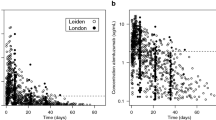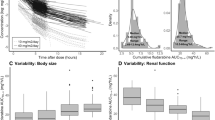Abstract
Purpose
Alemtuzumab is a humanized monoclonal antibody against CD52 which is predominantly present on T and B lymphocytes. Alemtuzumab has been used as part of conditioning regimens for prophylaxis against rejection and GVHD. While the mechanism of action is well understood, the pharmacokinetics of this drug in children needed to be studied in more detail especially in the setting of ex vivo T-cell-depleted hematopoietic cell transplantation (HCT).
Methods
Serum alemtuzumab levels were measured at various time points in 13 patients who underwent haploidentical HCT utilizing ex vivo donor T-cell depletion. Alemtuzumab was administered subcutaneously at a cumulative dose of 45 mg/m2 from days − 13 to − 11. A one-compartmental model was used to fit the data using non-linear mixed effects modeling.
Results
We determined the median half-life to be 11 days. Alemtuzumab clearance increased with increasing baseline lymphocyte count (p = 0.008). Additionally, clearance increased with weight and age (p ≤ 0.035). AUC of alemtuzumab did not have any significant relationship with type of leukemia, overall survival, engraftment, immune reconstitution, mixed chimerism or GVHD, although the number of subjects in this pilot study was limited.
Conclusion
Absolute lymphocyte count and body weight affect alemtuzumab clearance. We also demonstrate feasibility of body-surface area-based dosing of alemtuzumab in pediatric HCT patients. Further studies are needed to evaluate the role of monitoring alemtuzumab serum concentrations to balance the prevention of graft rejection and GVHD with the promotion of rapid donor immune reconstitution.




Similar content being viewed by others
Availability of data and transplarency
Data are available at request.
References
Alexander TB, Wang L, Inaba H, Triplett BM, Pounds S, Ribeiro RC, Pui CH, Rubnitz JE (2017) Decreased relapsed rate and treatment-related mortality contribute to improved outcomes for pediatric acute myeloid leukemia in successive clinical trials. Cancer 123(19):3791–3798. https://doi.org/10.1002/cncr.30791
Campana D, Pui C-H (2017) Minimal residual disease-guided therapy in childhood acute lymphoblastic leukemia. Blood 129(14):1913–1918. https://doi.org/10.1182/blood-2016-12-725804
Liu JH, Kanakry CG, Luznik L (2018) Have haploidentical transplants replaced umbilical cord transplants for acute leukemias? Curr Opin Hematol 25(2):103–111
Vadakekolathu J, Rutella S (2017) T-cell manipulation strategies to prevent graft-versus-host disease in haploidentical stem cell transplantation. Biomedicines. https://doi.org/10.3390/biomedicines5020033
Martelli MF, Di Ianni M, Ruggeri L, Pierini A, Falzetti F, Carotti A, Terenzi A, Reisner Y, Aversa F, Falini B, Velardi A (2014) "Designed" grafts for HLA-haploidentical stem cell transplantation. Blood 123(7):967–973. https://doi.org/10.1182/blood-2013-10-531764
Gribben JG, Hallek M (2009) Rediscovering alemtuzumab: current and emerging therapeutic roles. Br J Haematol 144(6):818–831. https://doi.org/10.1111/j.1365-2141.2008.07557.x
Kottaridis PD, Milligan DW, Chopra R, Chakraverty RK, Chakrabarti S, Robinson S, Peggs K, Verfuerth S, Pettengell R, Marsh JC, Schey S, Mahendra P, Morgan GJ, Hale G, Waldmann H, de Elvira MC, Williams CD, Devereux S, Linch DC, Goldstone AH, Mackinnon S (2000) In vivo CAMPATH-1H prevents graft-versus-host disease following nonmyeloablative stem cell transplantation. Blood 96(7):2419–2425
Marek A, Stern M, Chalandon Y, Ansari M, Ozsahin H, Gungor T, Gerber B, Kuhne T, Passweg JR, Gratwohl A, Tichelli A, Seger R, Schanz U, Halter J, Stussi G, Swiss Blood Stem Cell T (2014) The impact of T-cell depletion techniques on the outcome after haploidentical hematopoietic SCT. Bone Marrow Transplant 49(1):55–61. https://doi.org/10.1038/bmt.2013.132
Mould DR, Baumann A, Kuhlmann J, Keating MJ, Weitman S, Hillmen P, Brettman LR, Reif S, Bonate PL (2007) Population pharmacokinetics-pharmacodynamics of alemtuzumab (Campath) in patients with chronic lymphocytic leukaemia and its link to treatment response. Br J Clin Pharmacol 64(3):278–291. https://doi.org/10.1111/j.1365-2125.2007.02914.x
Admiraal R, Jol-van der Zijde CM, Furtado Silva JM, Knibbe CAJ, Lankester AC, Boelens JJ, Hale G, Etuk A, Wilson M, Adams S, Veys P, van Kesteren C, Bredius RGM (2019) Population pharmacokinetics of alemtuzumab (campath) in pediatric hematopoietic cell transplantation: towards individualized dosing to improve outcome. Clin Pharmacokinet 58(12):1609–1620. https://doi.org/10.1007/s40262-019-00782-0
Aversa F, Pierini A, Ruggeri L, Martelli MF, Velardi A (2019) The evolution of T cell depleted haploidentical transplantation. Front Immunol 10:2769. https://doi.org/10.3389/fimmu.2019.02769
Beal SL (2001) Ways to fit a PK model with some data below the quantification limit. J Pharmacokinet Pharmacodyn 28(5):481–504
Admiraal R, Lindemans CA, van Kesteren C, Bierings MB, Versluijs AB, Nierkens S, Boelens JJ (2016) Excellent T-cell reconstitution and survival depend on low ATG exposure after pediatric cord blood transplantation. Blood 128(23):2734–2741. https://doi.org/10.1182/blood-2016-06-721936
Abdel-Azim H, Mahadeo KM, Zhao Q, Khazal S, Kohn DB, Crooks GM, Shah AJ, Kapoor N (2015) Unrelated donor hematopoietic stem cell transplantation for the treatment of non-malignant genetic diseases: an alemtuzumab based regimen is associated with cure of clinical disease; earlier clearance of alemtuzumab may be associated with graft rejection. Am J Hematol 90(11):1021–1026. https://doi.org/10.1002/ajh.24141
Marsh RA, Lane A, Mehta PA, Neumeier L, Jodele S, Davies SM, Filipovich AH (2016) Alemtuzumab levels impact acute GVHD, mixed chimerism, and lymphocyte recovery following alemtuzumab, fludarabine, and melphalan RIC HCT. Blood 127(4):503–512. https://doi.org/10.1182/blood-2015-07-659672
Mahadeo KM, Weinberg KI, Abdel-Azim H, Miklos DB, Killen R, Kohn D, Crooks GM, Shah AJ, Kharbanda S, Agarwal R, Kapoor N (2015) A reduced-toxicity regimen is associated with durable engraftment and clinical cure of nonmalignant genetic diseases among children undergoing blood and marrow transplantation with an HLA-matched related donor. Biol Blood Marrow Transplant 21(3):440–444. https://doi.org/10.1016/j.bbmt.2014.11.005
Rebello P, Cwynarski K, Varughese M, Eades A, Apperley JF, Hale G (2001) Pharmacokinetics of CAMPATH-1H in BMT patients. Cytotherapy 3(4):261–267. https://doi.org/10.1080/146532401317070899
Spyridonidis A, Liga M, Triantafyllou E, Themeli M, Marangos M, Karakantza M, Zoumbos N (2011) Pharmacokinetics and clinical activity of very low-dose alemtuzumab in transplantation for acute leukemia. Bone Marrow Transplant 46(10):1363–1368. https://doi.org/10.1038/bmt.2010.308
Oshima K, Kanda Y, Nakahara F, Shoda E, Suzuki T, Imai Y, Watanabe T, Asai T, Izutsu K, Ogawa S, Motokura T, Chiba S, Kurokawa M (2006) Pharmacokinetics of alemtuzumab after haploidentical HLA-mismatched hematopoietic stem cell transplantation using in vivo alemtuzumab with or without CD52-positive malignancies. Am J Hematol 81(11):875–879. https://doi.org/10.1002/ajh.20694
Kako S, Gomyo A, Akahoshi Y, Harada N, Kameda K, Ugai T, Wada H, Ishihara Y, Kawamura K, Sakamoto K, Sato M, Terasako-Saito K, Kimura S-I, Kikuchi M, Nakasone H, Kanda J, Kanda Y (2019) Haploidentical transplantation using low-dose alemtuzumab: comparison with haploidentical transplantation using low-dose thymoglobulin. Eur J Haematol 102(3):256–264. https://doi.org/10.1111/ejh.13204
Admiraal R, van Kesteren C, Nierkens S, Boelens J-J, Lacna AM, Ebskamp-van Raaij L (2016) Individualized dosing and therapeutic drug monitoring for anti-thymocyte globulin to improve outcome following cord blood transplantation: proof of concept. Biol Blood Marrow Transplant 22(3):S116
Lindemans CA, Admiraal R, Haar CG, van Raaij LEE, Lacna AM, Bierings M, Nierkens S, Boelens J-J (2017) Individualized dosing and therapeutic drug monitoring (TDM) of ATG is feasible, safe, effective, and associated with excellent immune reconstitution. Biol Blood Marrow Transplant 23(3):S124–S125
Acknowledgements
This work is supported, in part, by the National Cancer Institute Cancer Center Support (CORE) grant P30 CA021765 and the American Lebanese Syrian Associated Charities (ALSAC).
Funding
This work is supported, in part, by the National Cancer Institute Cancer Center Support (CORE) grant P30 CA021765 and the American Lebanese Syrian Associated Charities (ALSAC).
Author information
Authors and Affiliations
Contributions
SVB, SC, and JCP analyzed data. BMT designed clinical trial and supervised the project. All authors wrote the manuscript.
Corresponding author
Ethics declarations
Conflict of interest
B.M.T. received travel support for EBMT 2018 Annual Meeting from Miltenyi Biotec Inc to present published data. The remaining authors declare no competing financial interests.
Ethics approval
This work was approved by IRB and Ethics Committee of our institution.
Consent to participate
Informed consent obtained from patients and/or parents.
Consent for publication
Informed consent obtained from patients and/or parents.
Code availability
Not applicable.
Additional information
Publisher's Note
Springer Nature remains neutral with regard to jurisdictional claims in published maps and institutional affiliations.
Electronic supplementary material
Below is the link to the electronic supplementary material.
280_2020_4160_MOESM2_ESM.pdf
Supplemental Figure S1. Goodness-of-Fit plots. Black dots: measured concentrations/residuals; Red dots: simulated concentrations below the LLOQ (141 ng/mL); Panel A: individual predicted vs actual concentration; Panel B: population predicted vs actual concentration; Panel C: individual weighted residuals vs time; Panel D: population weighted residual vs time. (PDF 334 kb)
Rights and permissions
About this article
Cite this article
Bhoopalan, S.V., Cross, S.J., Panetta, J.C. et al. Pharmacokinetics of alemtuzumab in pediatric patients undergoing ex vivo T-cell-depleted haploidentical hematopoietic cell transplantation. Cancer Chemother Pharmacol 86, 711–717 (2020). https://doi.org/10.1007/s00280-020-04160-7
Received:
Accepted:
Published:
Issue Date:
DOI: https://doi.org/10.1007/s00280-020-04160-7




